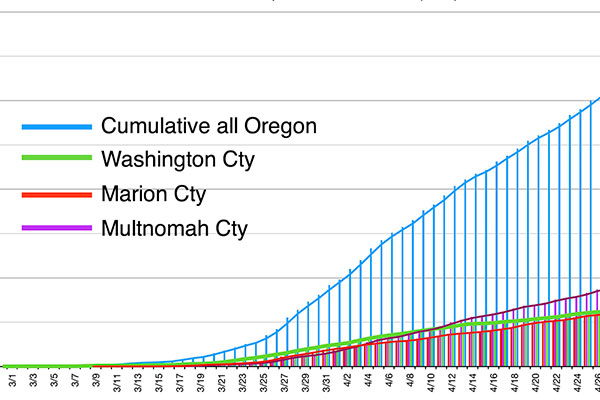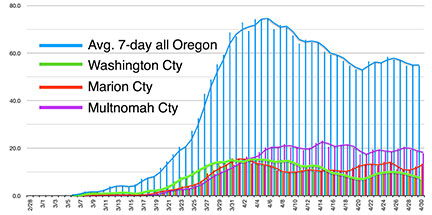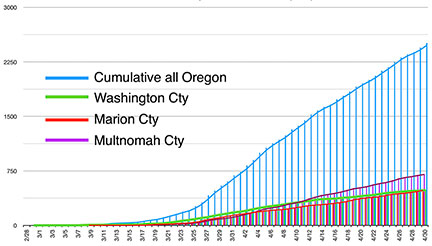COVID-19 in Washington County

May 2020 update
- County will follow Oregon governor on reopening
- Extending the Emergency Declaration
- County Emergency Operations Center
County will follow Oregon governor on reopening
According to Wendy Gordon, Lead Public Information Officer, Washington County Emergency Operations Center, Washington County will follow the governor’s plan on when and how to reopen. On April 14, Brown’s office introduced a “Framework for Reopening Oregon” that outlines the prerequisites for the safe way to move forward.

It’s apparent that new cases in the state of Oregon and in Washington County peaked in early April and have decreased, but that, on average, the number of new cases reported each day has been staying fairly constant over the last two weeks. So, according to the testing and reporting done thus far, we in Oregon have been able to “flatten the curve”, but we still have new cases occurring each day.
Graph and comments by Carol Horton, Cedar Mill News resident
“In order to begin reopening communities, Oregon must first slow the growth of COVID-19, as well as acquire adequate personal protective equipment to protect health care workers and first responders. Once those prerequisites are met, Oregon can begin to reopen by:
- Ramping up COVID-19 testing capacity in every region of Oregon
- Developing robust contact tracing systems to track and contain COVID-19 cases
- Establishing a quarantine and isolation program for new cases
Brown said, “We will take a look at specific sectors of the economy: restaurants and food service, retailers, childcare, and personal services, like hair and nail salons. We want to bring together business owners and practitioners with health professionals to discuss how reopening gradually in these sectors might be accomplished. For example, this might include additional guidelines for reconfiguring the delivery of services with added physical barriers like plexiglass dividers, or requirements for wearing PPE.”
She concluded her remarks saying, “This is going to move much slower than any of us want, but that is the only way to protect the health and safety of Oregonians.”
Brown announced on May 1 that the state, in partnership with OHSU, will conduct a statewide COVID-19 research study to “inform the approach for reopening.” A research team with OHSU will be randomly inviting 100,000 Oregonians to voluntarily participate in the study called “Key to Oregon.”
Learn more here.
Participants will:
- Be selected at random to represent the state’s ethnic, socioeconomic and geographically diverse population.
- Receive an invitation to enroll, via U.S. mail, starting the week of May 11.
- Monitor their temperature and other symptoms every day over 12 months using state-of-the-art technology, such as Kinsa smart thermometers, to collect real-time data.
- If they show symptoms, they will receive a home test kit. This will enable them to detect the virus at its earliest stage so they can better protect themselves, their family and the community.
- Be referred to the Oregon Health Authority for follow-up and appropriate action as needed.

There are several interesting things to note here:
• Multnomah County has overtaken Washington County in number of COVID-19 cases.
• Marion County has the same number of cases (491) as Washington County,
• Washington County’s growth curve is flatter than either Multnomah or Marion Counties.
In addition, up to 10,000 randomly selected participants will also receive home testing kits to provide data about symptom-free infections, and to prevent wider spread in the community and state.
All test results will be reported to the Oregon Health Authority to help with contact tracing and home isolation of those who test positive. In contact tracing, people who may have come in contact with an infected person are identified to raise awareness of COVID-19 symptoms and to take steps to limit disease spread in their household and the community.
Additional measures include unified coordination among all hospital labs to optimize Oregon’s available testing capacity, acting as one statewide system that will allocate resources to meet the state’s testing needs in every region. There will be a focus on collecting data to serve at-risk communities.
Governor Brown’s contact tracing plan sets a goal of training at least 600 contact tracers, deployed statewide by county, with a focus on recruiting individuals with cultural and linguistic competence for the populations they serve.

Extending the Emergency Declaration
At its May 5 meeting, the Board of County Commissioners (BCC) voted to extend the length of emergency declarations.
The County has been under an emergency declaration since March 4, 2020. Under current rules, a declaration of emergency can only last 14 days. The BCC has needed to extend that declaration on four separate occasions. In order to more efficiently use resources during this emergency, the length of the declaration needs to be extended. The proposed ordinance amends the Code to extend the emergency declaration for up to thirty days.
As the County is under an emergency declaration, County Counsel proposes an emergency ordinance that can be effective immediately upon adoption following Charter procedures. A typical ordinance requires an introduction and first reading followed in 14 days by a second reading, public hearing and adoption with an effective date of 30 days. The emergency charter proceedings allows a first reading, followed by a public hearing, followed by adoption and the ordinance can become effective immediately.
County Emergency Operations Center
The county’s emergency operations center (EOC) activated soon after the first case of new coronavirus was reported on February 28. The coordinating center serves to support public health operations and to coordinate the multi-agency response to the outbreak. Over 100 staff and representatives from several community partners have been working in the EOC since that time, using appropriate social distancing.
Objectives for the Washington County EOC include:
- Continued coordination around community-wide compliance with Governor Kate Brown’s “Stay Home, Save Lives” order;
- Planning for the eventual implementation of the governor’s Framework for Reopening Oregon in Washington County;
- Preparing for increased testing and expanded isolation and quarantine of COVID-19 cases following the lifting of the governor’s “Stay Home, Save Lives” order;
- Supporting public health tracking, monitoring and support of households where positive cases have been reported;
- Developing and implementing strategies to slow disease spread in long-term care and other congregate housing facilities, at migrant farmworker work sites and in other community settings that are disproportionately impacted;
- Assisting with resources for health care providers performing patient care;
- Ensuring that all EOC sections incorporate equity considerations and prioritize support to vulnerable populations and marginalized communities;
- Assessing and monitoring the impacts to essential needs with a focus on vulnerable populations and marginalized communities and coordinating with community-based organizations to develop and implement strategies to address identified gaps and connect people in need with resources;
- Assessing and monitoring the behavioral health impact of the COVID-19 pandemic and developing strategies to address gaps and improve overall mental health and well-being; and
- Supporting and coordinating countywide and regional recovery from the pandemic by initiating efforts to recover county costs through state and federal disaster assistance programs and connecting businesses and individuals with economic assistance programs.
The county recently announced that John Wheeler has been appointed to serve as the County’s new Emergency Management manager as of April 18. Wheeler has a long career in emergency management, including nearly 20 years as the Emergency Management coordinator for Clark Regional Emergency Services Agency (CRESA) in Vancouver, Washington. In December 2015, he was hired as Washington County’s Emergency Management supervisor and had been serving as interim manager since October of 2019. Since early March, Wheeler has been helping to lead the County’s Emergency Operations Center (EOC) to provide multi-agency coordination, public information and community outreach during the COVID-19 pandemic.





